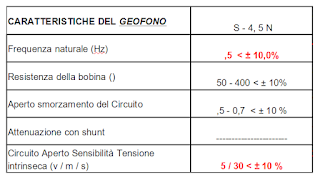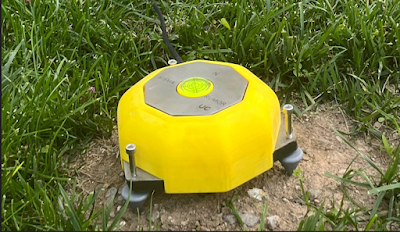TOMOGRAFO
PER ACQUISIZIONE HVRS
SOFTWARE DI UTILIZZO : THEREMINO_DOLFRANG V_5.4
- ) Master Theremino; ha la funzione di trasmettere i dati convertiti in digitale al pc tramite interfaccia USB con una frequenza di campionamento di 100 200 250 333 400 500 hz /canale
- ) scheda ADC 24 BIT - 16 CANALI, un adconverter
molto più
sensibile
dell'adc contenuto nel pic del Theremino Master ed ha la possibilità
di amplificare ogni canale con un gain 1, 2, 4, 8, 16, 32, 64, 128 x,
il filtraggio gestibile da software applicabile a tutti i canali attivati, frequenza di campionamento = 100 200 250 333 400 500 hz /canale
durata di acquisizione fino ad un massimo di 5 or - ) ADC 24 BIT reale, l’acquisizione
del segnale avviene totalmente nell’ AD7121B (cerchiata
in giallo nell’immagine allegata) a 24 Bit
Altre funzioni: amplificazione del segnale e filtraggio dei canali attivati
Acquisizione e conversione dei dati da analogici in digitali avvengono tramite l’ADC cerchiato in giallo ,
il resto dell’hardware Theremino ha solo funzioni di trasmettere i dati numerici acquisiti al pc in modalità USB al Pc
Dimensioni del circuito 6 x 3 cm, tutto il sistema di acquisizione è contenuto nell'ADC di 8 x 8 x 2 mm 64 pin.
Le specifiche tecniche sono chiaramente indicate al seguente link utile per confrontare le specifiche tecniche con quelle di altri strumenti analoghi:
https://www.analog.com/media/en/technical-documentation/data-sheets/ad7124-8.pdf
Il documento è una vera certificazione dello strumento in quanto come indicato in precedenza tutte le funzioni del tromografo amplificazione, filtraggio e conversione dei dati da digitale in analogico vengono svolte dall' ad712 ( cerchiato in giallo), la restante parte dell'hardware è un normalissimo WiFi per trasmettere i dati acquisiti al pc.
4) Geofoni da 4.5 Hz
CARATTERISTICHE COSTRUTTIVE:
Il tomografo sperimentale è stato costruito dal geol. Carlo Conte e dall’ing. Finlandese Ulf Nygren, su indicazioni del dott. Angelo Dolmetta che ha una consolidata esperienza quarantennale nel campo della geofisica e acquisizione dati digitale.
1)PER RIDURRE L'ATTRITO CON IL VENTO: Lo
strumento è di forma Esagonale con basso indice di aerodinamicità,
ha un altezza da terra di 9 cm e una larghezza di 19 cm , alla base
la piastra esagonale con tre lati ad angolo, in Ferro Dolce, ha uno
spessore 15 mm, un volume di 315 cm3 .
L’involucro
di forma ad emisfero esagonale costruita in Acido Poliattico ha una
struttura interna ad alveare in modo da ridurre al minimo i rumori
antropici, all’interno contiene i geofoni da 4,5 hz posizionati ad
una distanza di 0.7 mm dalla piastra in ferro dolce, nella parte
superiore una Piastra in ferro dolce consente allo strumento una
maggiore equilibrio nel posizionamento.
2) PIEDINATURA SUFFICIENTEMENTE DISTANZIATA: per permettere la massima stabilità del sistema, i tre piedini tra loro sono equidistanti (per garantire esatta risposta in frequenza nelle tre direzioni
3) MESSA IN NOLLA MANUALE: Lo strumento poggia a terra con i piedini avvitati alla piastra in ferro e possono essere livellanti al fine di
mettere in bolla lo strumento.
4) ZAVORRA DI STABILIZZAZIONE: La piastra di zavorra è stata concepita per raggiungere un peso di 2,50 kg per aumentare il contatto con il terremo, ciò consente allo strumento di essere perfettamente zavorrato e sufficiente e garantire la massima stabilità del sistema anche in caso di vento e/o rumori antropici e/o ambientali
5) BARICENTRO STRUMENTALE RIBASSATO; per garantire ulteriormente la massima stabilità strumentale.
6) USCITA CAVO USB; per non generare rumori prodotte dal vento il connettore del cavo è posizionato a piano campagna e non verticalmente.
Tutti gli elementi sopra indicati associati ad una elettronica innovativa a basso consumo e massina autonomia, permette di ottenere ottime prestazioni.
Il sistema quando non viene utilizzato come tromografo cambiando il software di gestione potrà essere utilizzato come sismografo per la registrazione di terremoti
Acquisizioni e comparazioni di curve H/V con altri strumenti simili hanno dimostrato un’attendibilità di grafici sovrapponibili e confrontabili.
Per info sull’utilizzo: geologoconte@libero.it
oppure cell 338.7522610
ALBUM FOTOGRAFICO




foto 8 riposizione dello strumento nel contenitore terminata l'indagine

Tomographic hvrs data acquisition
SISMA RUMOR UC
Compatible software : Theremino_Dolfrang V5.4
Recommended data processing software: GEOPSY 3.4.2 – SAF










Nessun commento:
Posta un commento